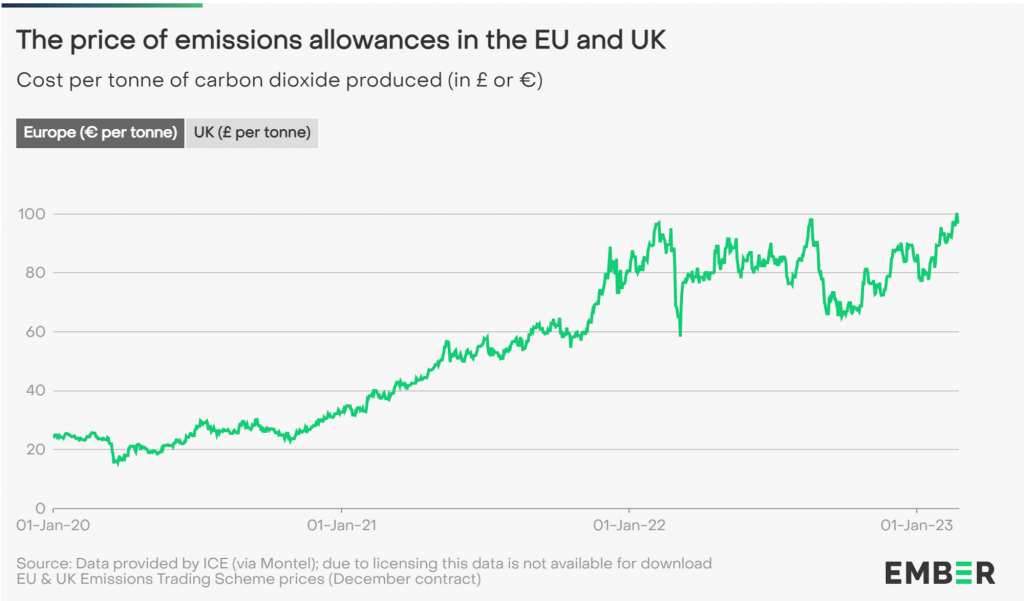In today’s issue, I want to show you what an internal carbon price is and how it can help transform your business into a climate-friendly one and make it future proof.
Not only will this set your company on a financially and economically sustainable path as carbon prices rise, but it will also provide your company with a tool for cost-efficient emission reduction.
Get the most out of your budget, remain competitive, and continue your success while helping the climate.
What are internal carbon prices?
Of course, many countries already have carbon prices in some ways. In Germany and other parts of Europe, many sectors (like electricity and aviation) are covered by the EU’s emission trading system (ETS). In this system, a fixed amount of emissions are allowed and there is a market where the rights to emit a ton of CO2 are traded. That way, when a coal power plant wants to produce electricity, they first must buy a certificate from someone else who then loses their right to emit. This is a market-based approach, and it works well for large markets and emissions which can be clearly assigned to a source.
When it comes to gasoline or diesel, it’s more difficult. Who is responsible for the emissions resulting from passenger cars driving around? Many would say the person or company who owns the car. But if millions of car owners need to buy emissions rights from the ETS to drive around, it would be a bureaucratic hell.

Instead, it was decided that already the refineries should pay the carbon price of the emissions which will come from these oil-based products at some point. The carbon price is then handed down to end-consumers directly by the price set by the oil companies to cover their cost.
And because refineries are not included in the ETS (yet), the German government decided to put a fixed price per ton of CO2 on oil and gas. This way, car owners, but also house owners who have an oil or gas heater, are incentivised to invest in more climate-friendly alternatives.
If you want to make sure that your company is fit for a future in which rising carbon prices pose a risk for your business, you should consider an internal carbon price.
It means that for every activity or process in your company (flying to customer, driving a company car, heating your office), you track the emissions and pay an “internal fee” for every ton emitted.
Pay to whom you might wonder. Internal carbon prices don’t necessarily mean that the carbon price paid go to offsetting your emissions. If you are in a larger organisation, you know that each department has a fixed budget, and departments can “invoice” each other for services provided. This internal accounting makes value provision visible and can equally be used for tracking (and penalising) emissions. So, if your department is booking flights to Fiji for the whole crew, in addition to (externally) paying for the flight tickets, you will also have to (internally) pay a fee for the CO2 emitted to, e.g., the sustainability department.
If you are a solopreneur or a startup, you’ll not have a sustainability department, but you can easily open another reserve position in your accounting to book the carbon price on or directly invest the money in carbon removal or offsetting.
Setting a Carbon Reduction Goal
Before you start setting up a carbon price, you should first formulate a carbon reduction goal for your business. For this, it makes sense to gather information to answer a couple of questions:
- How big are my emissions in total as a business?
- Which part of my activities/departments is causing these emissions?
- How fast do I want to decarbonise? (Hint: You should do as fast as possible.)
Then you can set a target that you (and your colleagues) can work towards every day. Without a goal, your efforts might be ill-directed, and you might spend your resources inefficiently, e.g., by implementing a system that has no effect.

Potential carbon reduction goals can be:
- Reach net-zero emissions by 2040 and half emissions by 2030 based on our 2022 emissions.
- Reach net-zero emissions by 2030 and offset all emissions which are caused until then.
Your goal must be specific, measurable, achievable, realistic, and terminated (SMART). It will be tailored to your company and your situation and abilities, but you should base it on the fact that the carbon budget is running out faster than you can say “ooops”. You can find more information on how to set the right targets at the Science Based Targets Initiative.
Determining the Carbon Price
A fixed carbon price does not directly translate to a specific reduction in greenhouse gas emissions. But an higher price will lead to more reduction than a lower price. If you have identified the largest sources of emissions in you company, you can rank them by the carbon price needed to shift these emitting processes to a green alternative.
For example, when you compare these to exemplary cases:
- Taking a flight costs 100 €, but causes 1.1 tons of CO2, while
- Taking the train for the same route is 200 €, but causes 0.1 tons of CO2
To impact the decision-making process and shift the selection from the cheaper flight to a more expensive train, the flight, which causes 1 ton more CO2 than the train must become 100 € more expensive. Therefore, you can determine that the internal carbon price must be at least 100 € divided by 1 ton, so 100 €/t of CO2.
Comparing the current cost of processes with their green alternative gives you an estimate of how high an internal carbon price must be to reduce your emissions from that source. You can then sort the sources by the carbon price needed to make the shift and use this “abatement cost curve” to determine the price needed to reach your emission reduction target.
Did that sound to complex and you want to get it done faster? No problem! Just use an external reference to set your internal carbon price (or set it to 100 €/t)!
Using an External Reference for Your Internal Carbon Price
The process I described above is happening automatically every day. At the carbon markets, like the ETS, companies buy certificates if it is cheaper than to decarbonise their process and others sell if it is already cheaper to save their emissions and sell the certificate instead.
For example, you could just use the ETS price as a reference to set your internal carbon price. It recently grew beyond 100 €/t and will increase more in the next years. You won’t need to update your internal price every minute, but looking at the most recent price when doing your internal accounting might make sense.

Alternative, you can connect to systems that offset your emissions directly (like Carbonside) and therefore implicitly apply the price of the offset for all your emission.
Communicating the Internal Carbon Price
When you implement an Internal Carbon Price for your company, the most important part about it is communication. No, seriously. You must explain to your employees, partners, and customers:
- why you are introducing it,
- how high it will be,
- how it affects them and how the process works.
If your employees don’t know your target, they won’t be able to consider it. If they don’t know how high the carbon price is, they cannot make reasonable financial decisions. You have to provide them with the understanding, means, and tools to incorporate the carbon price into their day-to-day work without hindering them doing their job.
Tracking and Reviewing Progress
Whether your carbon price has exactly the effect you hoped for cannot be known until you implemented it. All the more important it is to track your emission and your progress towards your carbon reduction goal.
At the end of each year (at least) you should look at your total emissions again and check whether you achieved your goal for this year. If did, congrats! If you didn’t, however, your price was too low. You will have to increase it more strongly to compensate for your over-emitted CO2.
If you are a larger corporate or medium-sized company, there are a lot of reporting frameworks like the GHG Protocol that require you to publish your emissions in a transparent manner and provide you with the publicity needed to drive change, but also to get acknowledgement for your achievement.
Conclusion
An internal carbon price can drive the shift to a more sustainable business within your company, whether you are a big or a small one. The most important steps for implementing one are:
- Set a science-based emission reduction target
- Determine your carbon price
- Communicate this price internally and externally (good marketing if your price is reasonable)
- Track and review your progress and continuously adjust your internal carbon price.
Let me know in the comments how you approached the implementation of an internal carbon price!
See you next week. 😉 (Haven’t subscribed to The Climate Innovator newsletter yet? Join here!)
Photo by Ashraf Ali on Unsplash





